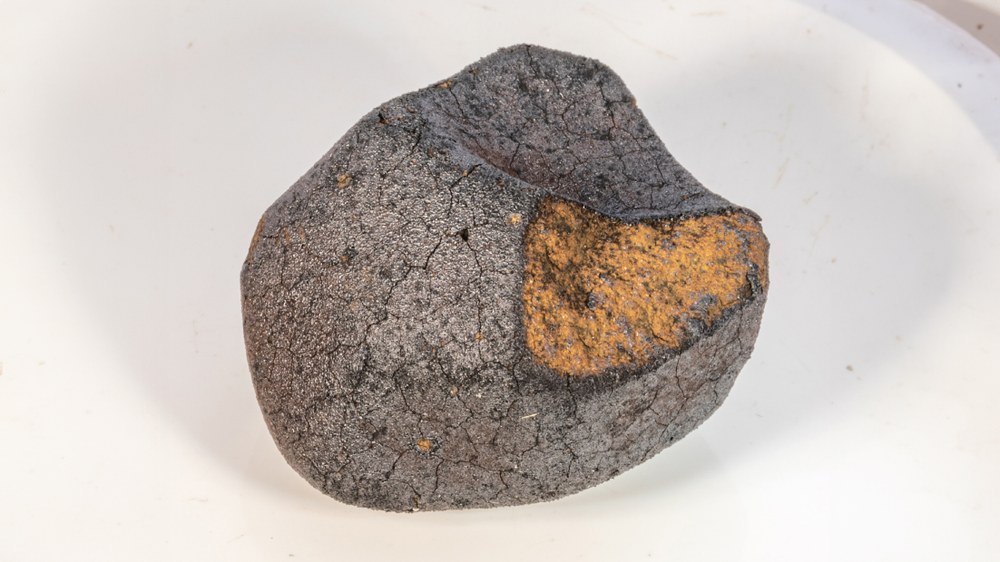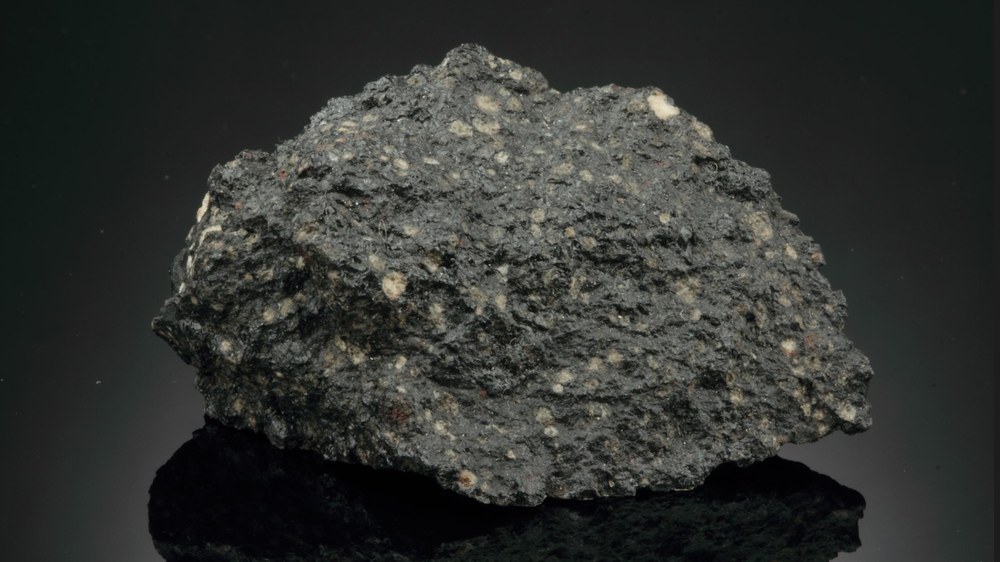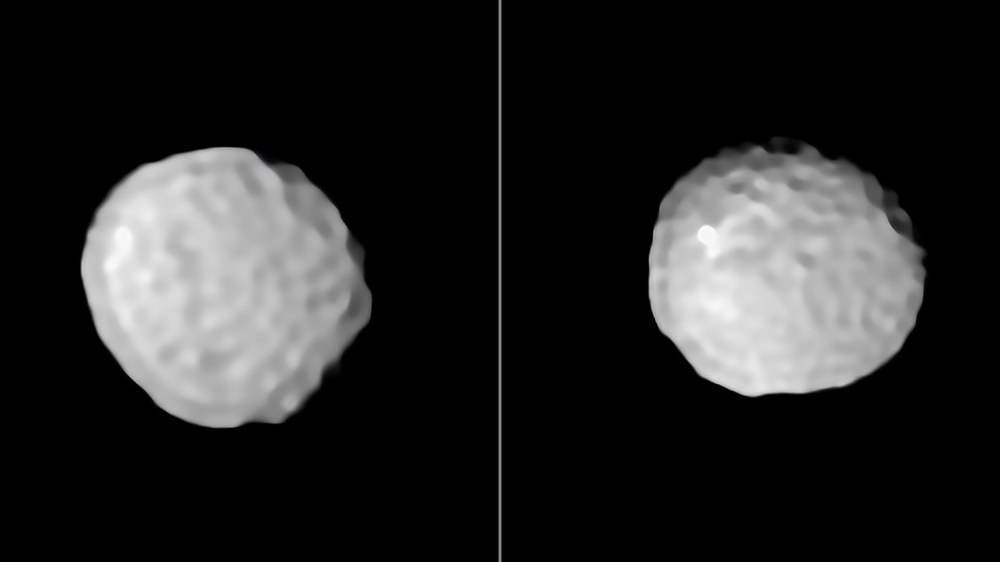How Earth got its water

Carsten Jonas CC BY-SA 4.0

University Museum of Earth Sciences, Rome

ESO/M. Marsset et al./MISTRAL-Algorithmus (ONERA/CNRS)
- The planets formed quickly through the various stages of accretion of planetesimals, their original building blocks.
- As early planetesimals were too hot for retaining water, they could not have brought any to Earth.
- Studies of younger meteorites from the outer Solar System show that their parent bodies formed later and at lower temperatures.
- These parent bodies retained their water, which later reached Earth via meteorites and asteroids.
- Focus: Space science, planetary research, meteorites, exploration of the Solar System
Although water is essential for the existence of life on Earth, its presence on our planet was by no means a foregone conclusion. Millions of asteroid fragments from regions of the Solar System far from the Sun are likely to have brought a considerable amount of the water in Earth's oceans, and a recent study shows that this was only possible because the water-rich building blocks of the Solar System formed later, more slowly and at lower temperatures. By contrast, planetesimals further towards the centre of the Solar System contained little or no water or ice because they formed more quickly and at higher temperatures. Earth became the Blue Planet thanks to planetesimals that formed relatively late and far from the Sun.
The German Aerospace Center (Deutsches Zentrum für Luft- und Raumfahrt; DLR) was closely involved in the study, which has now been published in the journal Scientific Reports (Nature Portfolio)." Had there not been this delay in the formation of the planetesimals, Earth would be a bone-dry planet today," says lead author Wladimir Neumann of the DLR Institute of Planetary Research and the Institute of Geodesy at Technische Universität Berlin. "Put simply, their distance from the Sun at the time of their formation was crucial for both the composition of the planetesimals." Far out in the thinning disc of dust and gas, planetesimals formed somewhat later and more slowly than in the inner Solar System, a critical phenomenon that occurred again and again. "The late planetesimals did not become so hot and as such did not lose the water they contained," Neumann continues. "Later, many of these water-rich planetesimals reached the inner Solar System, probably bringing large amounts of water to Earth." This may also be how our outer planetary neighbour Mars acquired the water that it has since almost completely lost, but whose traces can still be seen today. It has been suggested that Venus may also have had water for several hundred million years in its early stages.
Planetary building blocks formed in just a few million years
By astronomical standards, things happened very quickly during the earliest period of the Solar System. After the explosion of two or more burnt-out stars in one of the spiral arms of the Milky Way, the gases of these supernovae remnants condensed to form a new star. Some 4.5 billion years ago, it had accumulated so much mass that hydrogen atoms fused into helium in its interior, generating energy. The new star that formed was the Sun, orbited by an accretion disc made of the dust and gas left over from this process and extending billions of kilometres into space.
The building blocks of the planets were created within the accretion disc. Meteorites, fragments of parent bodies that formed at that time, bear witness to this. Around 86 percent of meteorites are chondrites, which in turn contain chondrules, or small spheres. Chondrules were formed in the protoplanetary disc at different times over the course of a few million years when material was flash heated and melted, forming droplets. The droplets then solidified and clumped together with dust and gases, including water, to form larger bodies – the planetesimals. The planets were formed from these original building blocks in barely ten million years. The Sun 'ignited' 4.567 billion years ago, and the planets finished forming relatively soon after that. But as countless small bodies still remained, these were very turbulent times in the Solar System, with the young planets assailed by frequent impacts from asteroids and comets. In particular, asteroids from the outer zone of the main asteroid belt between Mars and Jupiter, which were formed beyond a distance from the Sun known as the ‘snow line’, are likely to have supplied Earth with large amounts of its water. For a long time however, it was unclear how the water got into the planetesimals.
Meteorites and asteroids reflect the early days of the Solar System
The origin of water on Earth has long been the subject of scientific debate. A considerable quantity probably comes from its interior and was blown into the atmosphere by volcanoes, whereupon it partially filled the first oceans as rain. But that was probably not the only source of water. So, did water come from beyond Earth?
Previously it was assumed that accretion processes occurred faster closer to the Sun than further away, not least because a higher material density within the disk favoured growth. However, this theory was called into question by the discovery of meteorites whose parent bodies were more developed, but which have isotope ratios that are identical in their geochemical signature to meteorites from undifferentiated parent bodies from the outer Solar System (isotopes are variants of a chemical element in which atoms have differing numbers of neutrons). The Scientific Reports study provides an explanation for this apparent anomaly by demonstrating that, in the outer part of the protoplanetary disc, there was a region where planetesimals were repeatedly formed over the disc's entire lifetime, from time zero to just under four million years later.
"We can show this by calculating the formation times for the meteorites' parent bodies, achieved by combining models of thermal evolution with the measured thermo-chronological data of the meteorites," Wladimir Neumann adds. For 20 years, scientists have been trying to overcome two major problems in our understanding of accretion. Firstly, models and laboratory tests have shown that dust clumps cannot grow beyond a size of one metre due to collisions, a phenomenon known as the 'metre-size barrier'. The inward drift of such dust clumps towards the centre of the disc or their breakup due to collisions at high speeds prevent them from growing any further, meaning that it is theoretically impossible for planetesimals to form.
Another difficulty arises from disc models that include predicted regions of high pressure. These areas act as traps for the dust particles and are large enough such that, rather than breaking up, matter collapses into planetesimals virtually on the spot. This happened everywhere in the accretion disc over the course of around 100,000 years. But it also meant that the planetesimals that formed in these particle traps became too hot to retain water due to the radioactive decay of the aluminium-26 isotope (26Al). Planetesimals that were created later had significantly less 26Al and so remained cooler.
Asteroid parent bodies formed over time do not become too hot for water
So, what caused the formation of parent bodies of meteorites that were cool enough not to lose the volatile water molecule? Wladimir Neumann and his co-authors from the Institute of Earth Sciences at the University of Heidelberg, the University of Bayreuth and the Swiss Federal Institute of Technology ETH Zurich found the key to this question in the study of carbon-rich meteorites whose parent bodies must have formed far from the Sun.
Among them was the 25-gram Flensburg meteorite, which fell from the sky on 12 September 2019. It contains minerals that could only crystallise in combination with water and whose parent body was formed 2.7 million years after the formation of the accretion disc, or time zero. The researchers also examined tafassites – meteorites significantly younger than those originating from parent bodies that, as mentioned above, only took 100,000 years to form. Lastly, meteorites were analysed from even younger parent bodies that formed at 3.7 million years after the birth of the Solar System.
These investigations lead to the conclusion that the two mechanisms described had opposing effects: on the one hand, the inward drifting within the disk prevents the planetesimals from forming, while on the other, the high-pressure areas with particle traps should actually cause planetesimals to form early and quickly. This occurred to varying degrees at different times and in various regions of the outer Solar System. In this way, the high-pressure areas prevented the complete loss of material, but the partial inward drift that nonetheless occurred avoided the mechanism by which all the material would be incorporated at a very early stage into planetesimals that then heat up and lose their water. As a result, there was still enough material remaining up to around four million years after the planet-generating accretion disc was formed to create planetesimals that were able to retain water. This probably ensured the supply of precious water to Earth some several hundred million years later – a stroke of luck for life on our planet!
